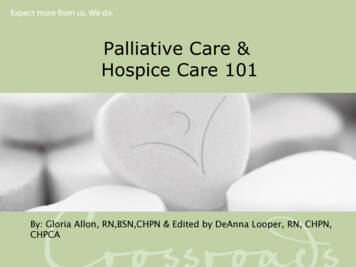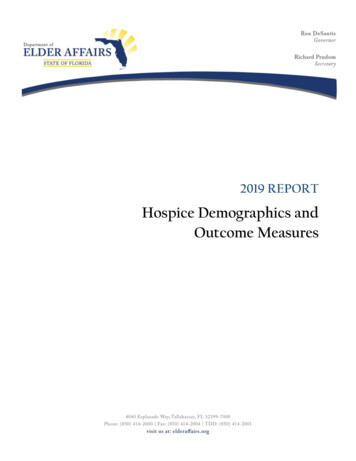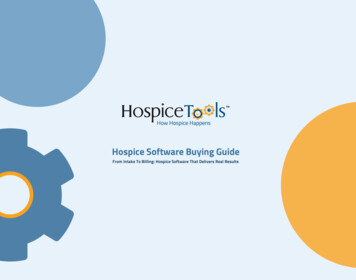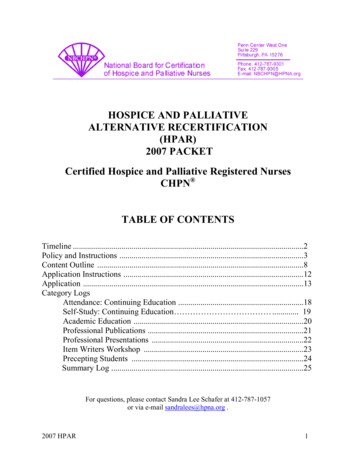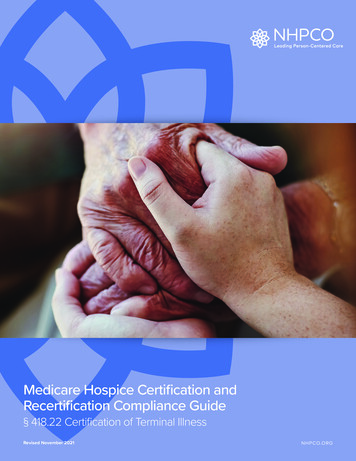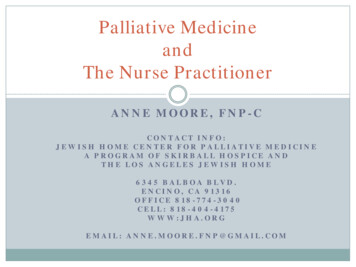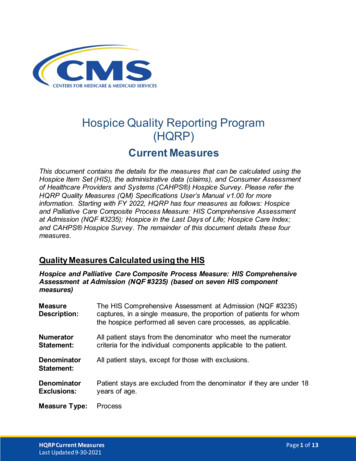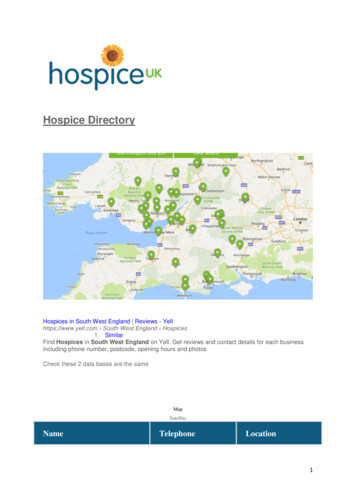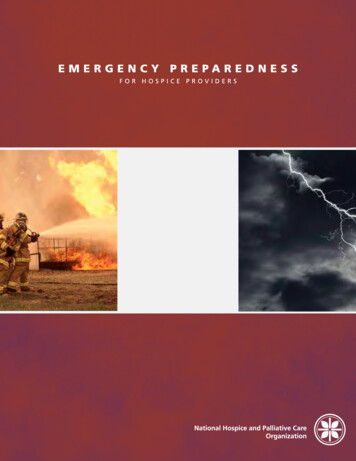
Transcription
Reimbursement of Hospice andPalliative Care in the VACaroline Schauer, VISN 23 Hospice and Palliative Care ProgramManager1
What’s the Vision of theVeterans HealthAdministration?Reliable access toquality palliative carefor all Veterans2
What is Palliative Care?Palliative Care:Focuses on improving a patient’squality of life by managing pain andother distressing symptoms of aserious illness. Palliative careshould be provided along withother medical treatments(AAHPM,2011).3
What is Hospice Care?Hospice is:Palliative care for patients in theirlast half year of life. Hospice carecan be provided in patient’shomes, hospice centers,hospitals, long-term care facilities,or wherever a patient resides(AAHPM, 2011).4
How is Hospice and Palliative CareReimbursed Throughout the EntireVHA? That is what we hope you will help usdetermine in VISN 235
Palliative Care Although Palliative Care is listed asbenefit in the Medical Benefits package,there is no uniform reimbursementprocedure to follow Each facility Home and Community BasedNurse is expected to assess the needs ofthe Veteran, determine what services theagency offers, and find anotherreimbursement mechanism, such ashome health to provide reimbursement6
VA-Paid Hospice Care Performance Measure set at an ADC of 45for FY11 for every VISN Every Veteran has a choice!Average Daily Census of VA-Paid Hospice140Average Daily Census120100FY10FY11Q180604020023 21 23 51 19 10 20 22 12 17 11 4 18 9VISN7 16 6 15 87
VA-Paid Hospice Care High number of Veterans under or noninsured Veterans have a choice There is an identified payment mechanismin place, but instructions were locatedwithin 5 different Directives andHandbooks Payment must be made following LUPArates, which is a government transfer ofHospice Medicare Rates to the LUPAsystem8
Community Hospice Services Draft VISN 23 Directive on CommunityHospice Services Consolidation of: VHA Directive 2008-041 VHA Handbook 1140.3 VHA Handbook 1140.5 VHA Handbook 1140.6 VHA IL 10-2004-0059
Community Hospice Services VA-Paid Hospice within VA closely follows the HospiceMedicare Guidelines, but hospices do not need to contactMedicare for authorization. It can help by explaining to hospice agencies that the VA islike a private insurance which requires authorization andcommunication.Veteran wantsVA-PaidHospiceVA in collaborationwith the hospicedetermineappropriate Level ofCareRoutineHome CareRespiteGeneralInPatientContinuousCare10
Community Hospice ServicesRoutine Home CareUsual level of care for patients athome, in the Nursing Home or inAssisted LivingHospices vary in their requirements for a live incaregiver, but if the veteran is safe to live alone,they should be able to have hospice services athomeMedications RELATED to the terminal illness should be paidfor by the hospice. Unrelated medications may continue to beprovided by the VA. Special equipment may or may not be partof the Hospice per diem package- basic equipment should beprovided.11
Community Hospice ServicesRoutine Home CareThe Hospice Plan of Care can be requested. It should beclear whether or not the VA physician is going to be theHospice Primary Physician.Hospice requires Certification of TerminalIllness from a VA Provider. This CAN be donethrough chart review by a VA provider.This level of care is paid for at a daily LUPA rate regardlessof the number of services or visits the Veteran is receiving.12
Community Hospice ServicesRespiteRespite through the VA Paid Hospice benefit has to beprovided in an inpatient setting that the hospice has acontract with to provide this level of care. Usually is ahospital, Nursing Home, or free standing HospiceHouse. Veteran is still eligible for VA Respite Benefits!The respite benefit is available to allow the caregiver“intermittent” periods of rest. Five consecutive daysevery 30 days is allowed but unusual, usually it is offeredevery 2-4 monthsThis level of care should be pre-authorized by the VA and ispaid for at a flat daily LUPA Respite rate (very close to RoutineHome Care rate). No additional payment for care that exceedsthis amount is generally authorized (additional diagnostictreatments or therapies)13
Community Hospice ServicesGeneral InPatientCare (GIP)Inpatient care within a VA Hospital/CLC is the preferred place ofcare. If unable to travel the distance, non-VA inpatient care canbe authorized with prior VA authorization.General InPatient through the VA Paid Hospice benefit has to beprovided in an inpatient setting that the hospice has a contractwith to provide this level of care. Usually is a hospital, but canbe a free standing Hospice House or Nursing Home.This level of care should be pre-authorized DAILY by the VA and ispaid for at a flat daily LUPA General InPatient rate and is allinclusive of any hospice related diagnostic testing, therapies, orsurgeries. The funds flow from the hospice to the site of GIP care.14
Community Hospice ServicesGeneral InPatient Care(GIP)General InPatient Care is for symptom management ornecessary treatment that will ultimately result in increasedcomfort.GIP care is meant to be short term- days to possibly a week.The daily LUPA rate is high to cover hospitalization costs, so dayto day authorization and updates are essential.VISN 23 HPC support is always available!Documentation can be requested.Discharge planning begins on the day of GIP admission. Thislevel of care is not intended for long term use. If Hospice Housecare is requested, clarification of level of care must be made asthe VA-Paid Hospice Care does not cover room and board.15
Community Hospice ServicesContinuous CareContinuous Care is for symptom management ornecessary treatment that will ultimately result in increasedcomfort. The level of complexity is similar to GIP but oneon-one care is provided at the patient’s home (or NursingHome).Continuous Care is meant to be short term- days to possibly aweek. The LUPA rate is HOURLY with a minimum off 8 hours.If at least 8 hours within the 24 hrs is not staffed the hospiceshould receive Routine Home Care rate for that day. Day today authorization and updates are essential.If Continuous Care is authorized, day to dayauthorization and updates are essential as this can bethe highest LUPA rate if staffed for 24 hrs. It may beappropriate for care to change back to Routine HomeCare if symptoms are managed.16
Catastrophic Enrollment andContract Nursing Home Veterans with life limiting illness who maynot have qualified for enrollment in thepast, may be eligible to enroll undercatastrophic disabled enrollment Enrollment is dependant upon disease andADL status Veterans who do not qualify for ContractNursing Home under any other programcan have their hospice care and nursinghome care provided and paid for by the VAin a Contract Nursing Home17
Community Hospice Services Each facility has a Hospice and PalliativeCare Consult Team to assist with problemsolving VA Hospital is first choice for Inpatient care The Community Health Nurse will determinebenefits to be authorized, but if thedetermination does not meet the goals of thepatient, please consult the HPC team,Caroline Schauer, or Dr. Jorge Ramirez18
VA Paid Care and Contract NH Care provided in a VA contract NH Assure that the hospice agency isMedicare Certified and a quality agency Determine with the hospice agency whatlevel of care will the Veteran be in?– Most care will be under Routine Home Carebecause this is considered their home– The GIP level of care can only be utilized if theHospice has a contract for that level of care inthat nursing home- 24 hour RN is required– Nursing home residents may receiveContinuous Care (nurse or aide at the bedside)as this is their home. Approved on a day to daybasis19
VA Paid Care and Contract NHPayment of Contract NH Care Utilize POV code 43 Separate authorization for both thecontract nursing home and the hospice VA payment should be directly to thehospice, not the nursing home If Veteran will receive 24/7 Hospice Oncall, nursing, social work, chaplain visitsthen per diem should be paid to thehospice If the hospice only visits once every twoweeks and is unable to provide additionalservices, the consult fee is suggested20
VA Paid Care and State VeteransHomes Veterans can now receive VA-PaidHospice care while residing in a StateVeterans Home. They may use Medicare,Medicaid if desired and available State Veterans Home must have acontract with a community hospice agency This may not be a feasible option forplacement of Veterans, but may improveoptions for care for Veterans residing in aState Vets Home Ensure that Veteran is residing in the areaof the Vets Home most appropriate tomeet their needs– May need to be moved to Skilled Care if a 21Dom resident and declining in functional status
Hospice Veteran Partnerships Hospices continue to serve non-enrolledVeterans Catastrophic enrollment does notfinancially penalize the VA system You as a hospice provider may be theperson who makes a difference in the lifeof that Veteran and family22
Communication of allCommunity Hospice Care Fee basis staff handle the billing and relyon the information they receive from theCommunity Health Nurse to code theauthorization correctly Bills must be submitted for each individualVeteran, not batch billed VA-paid statistics in VSSC are based onpaid bills It is essential that hospices bill the VA in atimely manner Please communicate any difficultiesencountered in approval or payment23
Honoring and Caringfor Veteransat the End of Life24
Routine Home Care The Hospice Plan of Care can be requested. It should be clear whether or not the VA physician is going to be the Hospice Primary Physician. Hospice requires Certification of Terminal Illness from a VA Provider. This CAN be done through chart review by a VA provider. This level of care is paid for at a daily LUPA rate regardless
